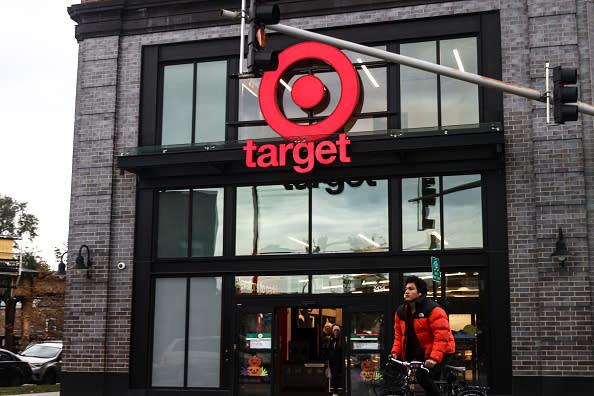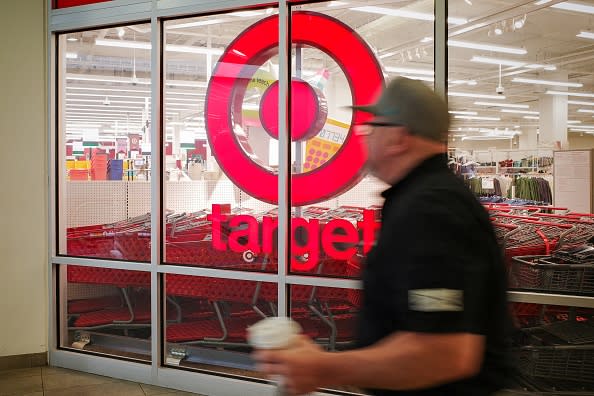Target Expecting Fewer Target Runs This Christmas, Trims Outlook

Target missed the mark on its latest quarterly earnings expectations.
The Minneapolis, Minnesota-based retailer reported earnings Wednesday before the market opened, revealing quarterly profits that were nearly cut in half as the firm continues to work through excess inventory issues and battles inflationary pressures. The company lowered its fourth-quarter expectations as a result, causing its shares to fall 13.1 percent to $155.47 on Wednesday.
More from WWD

“In the latter weeks of the quarter, sales and profit trends softened meaningfully, with guests’ shopping behavior increasingly impacted by inflation, rising interest rates and economic uncertainty,” Brian Cornell, chairman and chief executive officer of Target Corp., said in a statement. “This resulted in a third-quarter profit performance well below our expectations.
“While we’re ready to deliver exceptional value for our guests this holiday season, supported by the decisive inventory actions we took earlier this year, the rapidly evolving consumer environment means we’re planning the balance of the year more conservatively,” Cornell continued. “We’re also taking new actions to drive efficiencies now and in the future, optimizing our operations to match the scale of our business and drive continued growth. The strides we have made in recent years to build a truly differentiated, guest-centered retail offering, punctuated by a balanced, multicategory portfolio, positions us well to navigate in any environment. Looking ahead, we remain laser-focused on delivering the best of Target to our guests and continuing to invest in our long-term, profitable growth.”
The company logged $712 million in profits during the three-month period ending Oct. 29, compared with $1.48 billion last year. That’s on the heels of last quarter’s results, where Target’s profits fell by nearly 90 percent thanks to rapidly changing consumer preferences, which left the retailer with a glut of excess inventory.
In the most recent quarter, top-line results were slightly more favorable with $26.5 billion in total revenues, compared with $25.6 billion a year ago. Still, analysts were expecting closer to $26.38 billion in revenues.

A few bright spots during the quarter included comparable sales growth, which was up 2.7 percent, year-over-year, driven by a 1.4 percent increase in traffic and 1.3 percent increase in average ticket price, year-over-year. Comparable digital sales were up 0.3 percent during the quarter.
Beauty, food and beverage and household essentials continued to be growth drivers, helping offset softness in discretionary items. More specifically, beauty was up in the mid-teens during the quarter, with strength in skin care, hair care and cosmetics, while total sales volume of Ulta Beauty at Target nearly tripled, year-over-year, as they rolled out more shops-in-shop. Comparable sales in essentials also increased during the quarter, driven by pets and health. Meanwhile, soft sales trends in discretionary categories further weakened in the last few weeks of the quarter, a trend that continued into the first few weeks of November, according to Christina Hennington, executive vice president and chief growth officer for Target.
She added that apparel comps were “down only slightly” during the quarter, with strength in kids, men’s, seasonal and fashion-forward looks. As a whole, Target’s owned brands also outperformed national brands during the quarter, growing at double the rate in terms of total sales volume. Swim, women’s accessories and basics, however, declined. Sales in the home, toys and hardlines, including sporting goods and electronics, were also down for the quarter.

“We are disappointed given our bullish view that [Target] had previously cleared inventory and positioned the company well,” Oliver Chen, an analyst at Cowen, wrote in a note. “In the near term, we prefer broadlines with higher grocery and non-discretionary penetration as both [Costco] and [Walmart] hold 50 [percent] to 60 percent of core mix.”
Still, his firm rated Target’s stock “outperform” and set a price target of $210 a share.
Cornell told analysts on Wednesday’s morning’s conference call that, “While overall [third-quarter] comp growth was nearly identical to our second-quarter performance, we experienced dramatically different trends within the quarter. This rapid change in trend is consistent with what we’re seeing in syndicated data on broader industry trends and the feedback we’re hearing from our guests. More specifically, consumers are feeling increasing levels of stress, driven by persistently high inflation, rapidly rising interest rates and an elevated sense of uncertainty about their economic prospects. With high rates of inflation, continuing the road, their purchase power, many consumers this year have relied on borrowing or dipping into their savings to manage their weekly budgets. But for many consumers, those options are starting to run out.”
Gross margin rate for the quarter was 24.7 percent, compared with 28 percent last year, driven by higher markdown rates, inventory shrinkage, merchandise and freight costs, increased employee compensation costs and the cost of managing early inventory receipts. The company said a more favorable category mix and higher prices helped offset some of the pressure.
Target is now anticipating low-single-digit declines in comparable sales during the holiday shopping season, with an operating margin rate centered around 3 percent.
The firm also said it plans to save between $2 billion and $3 billion in the next three years by being more efficient, although it did not say how.
“I want to make it clear: This effort is not about slashing resources,” Cornell told analysts. “Instead, it’s about optimizing our operations to match the scale of our business.”
What the company did reveal during its earnings release was that it “was undertaking an enterprise-wide effort to simplify and gain efficiencies across its business with a focus on reducing complexities and lowering costs while continuing to support its team. These savings will support the company’s investments in driving deeper guest engagement and long-term growth while also delivering on its profit goals. This opportunity is enabled by the rapid growth since 2019, in which Target’s total revenue has grown approximately 40 percent. In light of this growth, this effort is focused on fully leveraging the scale that’s been gained to best position the company to continue growing efficiently over time.”
Headwinds also came from increased inventory. Target ended the quarter with $17.1 billion of its owned inventory, which was $5.7 billion higher than at the end of 2019’s pre-pandemic third quarter. Clearing through excess inventory means more promotions. It also cuts into quarterly profits.
In addition, while transportation costs are slowly dropping, they’re still higher than pre-pandemic levels. Executives on the call said global shipping rates are roughly three times higher than 2019’s rates, while fuel costs are more than double what the company paid in 2019.
“There are quite a few headwinds. But we’ve shown time and time again that our strengths can overcome any challenge we face,” Cornell said.
Analysts, however, were not convinced. Arun Sundaram, senior equity analyst at CFRA Research, maintained his “hold” option on Target’s stock, while reducing the firm’s 12-month price target to $162 a share.
“Clearly, [Target] is struggling more than [Walmart] due to its greater mix of discretionary goods, apart from beauty products, which was up in the mid-teens,” Sundaram wrote in a note. “We think it will be difficult for [Target] to return to its historical 6 percent to 7 percent operating margin next year, as weak comp sales trends are likely to result in operating deleveraging issues. We’re also concerned that the current heavy promotional environment could continue in 2023, with worsening shrinkage as a result of organized crime,” Sundaram wrote, referring to an uptick of theft in stores.
Target ended the quarter with $954 million in cash and cash equivalents and $14.2 billion in long-term debt. The retailer has nearly 2,000 stores around the U.S.
Target’s quarterly earnings reveal comes just one day after Walmart revealed losses in the last three months, despite its top-line performance that caused the world’s largest retailer to raise guidance for the year. Also similar to Walmart, Target has been on a multiyear journey to establish itself as a fashion destination.
In September, Target launched its 18th owned apparel brand called “Future Collective.” Ten of its owned brands are billion-dollar brands, including women’s activewear brand All in Motion. The retailer also revealed the latest design partners that same month and said it would hire roughly 100,000 seasonal workers for the holidays, the same number as last year.
Shares of Target have fallen by more than 41 percent over the past year.
